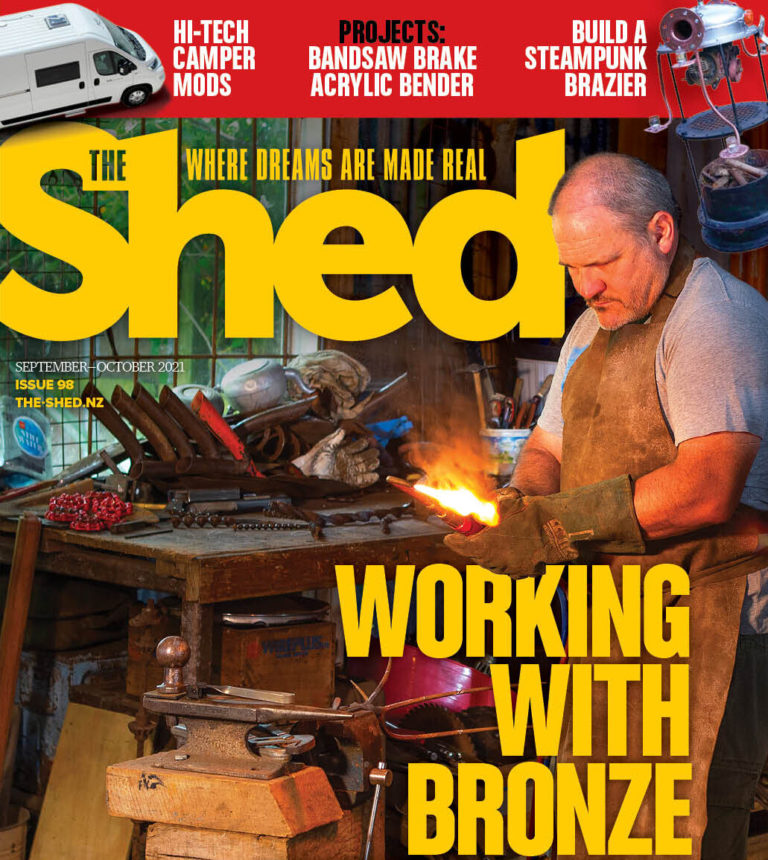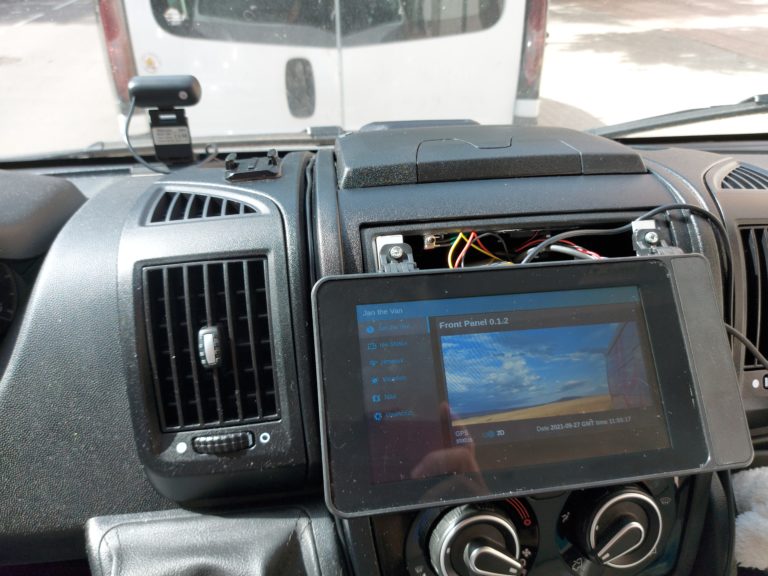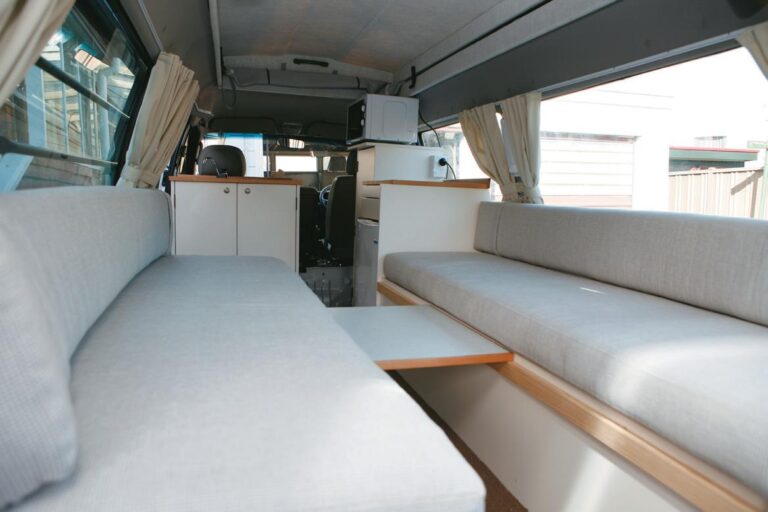On camper van holiday, carry your own scooter transport
By Geoff Merryweather
East Cape holiday—no worries with scooter carrier
Owning a campervan means you can take your house on holiday with you. The downside is you need to pack up your whole holiday site when you want to drive off and get some fish and chips for dinner. I considered towing a car behind the campervan but that was impractical. I use a scooter for commuting so the solution was obvious—put a scooter carrier on the campervan to give us an easy transport option on holiday.
The carrier is essentially an extension to the chassis. This extension carries a piece of the cross-rail channel running across the rear of the vehicle with tie-down points to hold the scooter.
The design of the carrier on our 2003 Mitsubishi Canter campervan is a combination of ideas I have seen here and overseas, and it has the added requirement that I also needed a carrier I could take apart easily. The material costs came to around $360 (new steel and lights) not counting the plywood offcuts or paint leftover from other projects.
Scooter carrier in place, with pivoting wheel clamp. Note ramp held upside down with bolts topped by wing nuts
Parameters
It’s technically fairly straightforward but the mounting design is important as the loading varies from that of a standard towbar, most cars being rated to 75 kg down-force and heavy-duty models on the campervan to 150 kg. A typical 50 cc scooter is around 85 kg and most trail bikes or larger scooters will be more. You have to add the weight of the carrier to this.
Some commercial carriers overseas fit into the hollow receiver hitch where the removable-tongue towbar sits. I was concerned about this loading, the stability, and the vibration. Only a single bar fixes this carrier to the vehicle and the scooter is loaded off-centre. It also means that the towbar isn’t available during this function.
Bumper bar slides out
Solution
For me, the vehicle chassis had to be strong enough to take a load further out than a towbar where forces acting on the chassis and bolts are higher. Do not stint on the mountings—if in doubt, get a towbar company to make the mountings and chassis modifications.
I ordered a towbar installed and since the campervan has a Certificate of Fitness (CoF), it needed to be a certified one. At the same time, I had the sockets made for the scooter carrier to slot in so that everything would fit together.
For the carrier, the law sets a four-metre limit from the axle to the rear of the vehicle. Ours is just 2.5 metres long—but it may become a bigger issue for bus-based motorhomes. There is further information on the NZTA website (http://www.nzta.govt.nz).
Planning
Consider whether the carrier you design will be for equipment other than a scooter. Also, note the effect of the carrier on the angle of the van starting off and the clearance needed over curbs and hills. As you lay out the carrier, use a straightedge or string line from the road up to the lowest part of the rear of the campervan and take this out to the rear of the vehicle. This height is the limit before something scrapes and the scooter carrier needs to be above this line. The trade-off is the carrier will be more awkward to use as it gets higher.
Scoter carrier box sleeves slide on carrier arms
Design
Given the items above, I decided my carrier had to have
-
the ability to be disassembled and stored in a limited space;
-
access to the towball for use with a trailer with a long drawbar;
-
upright support for the scooter so one person could tie it down;
-
lots of tie-down points;
-
provision for pushbikes;
-
loading access from either side.
I have a carrier that bolts together and comes apart in a few minutes for storage. It has a mounting for the cycle carrier rescued from the inorganic rubbish collection last year and a rocking cradle to support the front wheel to hold the bike upright.
Mounting arms
The carrier arms are made from 50 x 50 x 4 mm RHS box section. They fit into sockets on the towbar assembly and come out from under the body, then crank up at a 45º angle to provide clearance and access to the towbar. The final assembly has the scooter cross-rail 600 mm from the road.
A 50 x 50 mm rectangular hollow section (RHS) across the end of the carrier acts as a bumper bar and ties together the two carrier arms coming out from the towbar assembly. This bumper bar provides a mounting for the pushbike carrier and rear lights. It also acts as an additional tie-down location.
Carrier arms slot into towbar assembly
Carrier arms
The carrier arms must be identical without any twist in the final assembly, otherwise, the cross rail for the scooter and the bumper bar won’t slide into place. The welds must have good penetration and reinforcing.
Vee-out the joins and weld the first one, using a straightedge to make sure the horizontal sections of the arm are parallel. Clamp the second arm onto the first one and weld it up. I also welded plates over the welds to provide extra support.
The sockets into which the carrier arms slide were made by Aro Bros as part of the towbar and are 65 x 65 x 4 mm square hollow section (SHS) with a 16 mm through-hole. Pieces of 50 x 8 mm were welded to the arms as shims and ground down to provide a sliding fit.
The carrier arms when slid in are bolted to fasten them. Drill a 16mm hole for the through-bolts to fix them into the sockets and drill and tap M12 holes on the other end for the bumper bar retaining bolts. Assemble onto the vehicle. Check that they are parallel between the rails, level and that there is no twisting.
Ramp lip sits on scooter carrier channel
Scooter rail
The cross-rail on which the scooter sits is a U-shaped channel. It slides onto the carrier arms using two small pieces of box section welded underneath as the sliding sleeves. Due to time and budget constraints, I made the scooter rail from two pieces of 50 x 50 x 3 mm angle with 50 x 3 mm flat between to give a U-shape that is 150 mm wide x 50 mm high. Getting a channel folded up to specifications would be neater and make assembly easier. You can also buy 100 x 50 mm rolled channel but this is too narrow for most modern scooter tyres.
A piece of 12 mm plywood is bolted with 6 mm carriage bolts to the bottom of the channel. A folded channel would not need plywood.
The scooter front wheel is wedged against a vertical V-shaped stop made from two pieces of 100 x 3 mm flat at one end of this channel. A V-shaped cut to the end of the channel will accommodate this V-stop.
Before the channel is welded together, drill matching 12 mm holes along the 50 mm upright flanges of the angle sides. The scooter wheel pivoting clamp is bolted on through these holes. To allow for the back of the clamp to be moved to hold different-sized wheels, I drilled the holes at 25 mm centres from 200 mm to 500 mm from the end.
The scooter rail or channel fits onto the arms projecting from the camper van by the two box-section pieces welded underneath which act as sliding sleeves. These are held on the carrier arms by 12 mm bolts through the sleeves and tightened against the arms.
In terms of fitting box sections inside each other, 40 mm square slides into 50 mm square oaky but 50 mm square is too sloppy in 65 mm square, the next size up, Therefore, for the carrier rail sleeves in which the 50 mm square carrier arms fit, I welded up my own custom box section pieces using 50 x 5 mm and 65 x 5 mm flat.
|I clamped the flat onto an offcut of the 50 mm SHS used for the arms and used a 1 mm sheet metal as a shim for clearance. I welded them together then drilled and tapped the sides for the 12 mm clamping bolts.
Don’t weld these small box section sleeves onto the carrier rail at this stage. That is done last once all the bits can be assembled for fit.
Scooter wheel locked in place
Cranked carrier arm is reinforced
Wheel cradle
The cradle for the scooter front wheel is a shallow V that rocks over a centre and pushes the front wheel into the upright V at the end of the scooter-holding rail or channel. In section, looking down from above, it is V-shaped so when the bike is in place, it is wedged upright. In elevation, it touches the wheel around the 6 o’clock position and the 8 o’clock position, so that the weight of the bike forces the wheel into the V at the front. The exact angle isn’t critical, but if it is too steep it will be more difficult to get on and off and is less stable. If it is too shallow, it won’t hold the wheel in place.
This wheel-holding cradle is made from pieces of 50 x 5 mm flat, 50 mm long, welded together, with 25 x 10 mm ears for the mounting bolts that go through the carrier rail. Make the sides of the cradle narrow enough and steep enough so that the wheel doesn’t bottom out; the cradle should support the wheel so it is wedged in place to make the bike stable until the tie downs go on.
Allow for the plywood on the base of the scooter rail so that when the wheel is in place, the back of the clamp doesn’t quite touch the plywood. This means the weight of the bike on the front part of the wheel clamp pushes the wheel forward as it pivots around the hinge.
Lay the assembled channel with a clamp on the ground and roll the bike on and off. Everything should move easily and be not too hard to roll into place, with the bike being held steady and upright. Clamp the scooter cross-rail with the sleeves underneath into the carrier arms on the back of the vehicle. Measure everything carefully and make sure the arms are parallel and level before tacking everything in place.
There is a piece of 55 x 50 x 3 mm SHS at the front of the rail and a 40 mm SHS slides into this with a loop on each end to take the tie-down hooks. Initially, I found the scooter cross-rail was too flexible to hold the bike firmly and twisted when the bike rocked. I welded a piece of 65 x 35 mm RHS underneath this scooter channel to stiffen it.
Weld-on loops for the rear tie-downs onto each arm close to the back of the campervan and the matching bumper bar position.
Carrier assembly fixed to the chassis
Bumper bar
The bumper bar has welded to it two pieces of 40 x 40 x 4 mm square section. These slide into the open ends of the carrier arms. Take these pieces and slide them into place, do up the bolts and clamp the bumper bar steel, which is 50 x 50 SHS, onto them, and then tack weld it in place. This is easier if you have someone to hold everything while you weld.
The bumper bar is out far enough from the back of the campervan and scooter to take the ramp and also to protect the scooter in event of a bump from behind.
Slots for scooter carrier arms
Carrier arms slot into carrier assembly
Weld up
When the bolts are loosened, everything should come apart easily. Weld up everything fully and watch out for distortion, especially of the sliding-fit scooter cross-rail and bumper bar. I had to heat up some of the welds and pull them straight.
The pushbike carrier fits on the bumper bar. A piece of 40 mm pipe bolted with a 12M bolt through it acts as a “towball” for a standard pushbike carrier.
Welding up carrier arm and scooter rail
Welding flats to bottom of scooter carrier rail
Tacking bumper bar on box section sliders
Ramp
The ramp is also made of 50 x 50 x 3 mm pieces of angle iron with a plywood top. There is a lip which slides onto the end of the carrier rail so it won’t slide off. The ramp is held sitting across the carrier and upside down where it is fixed by two M12 bolts with a wing nut welded on the top so no tools are required for taking it off. The bolts fit into two threaded holes in tabs welded onto the bumper bar.
Lights
As the scooter blocks the lights at the back of the van, I welded a 100 x 3 mm flat on for reflectors and trailer lights, which wire into the trailer plug. Many truck-based motorhomes are 24V instead of the more usual 12V. Plugging in the 12V trailer lights gives you the excuse to go to the sales in search of new 24V bulbs. An alternative is a 12v/24v converter trailer plug that will also let you use standard trailers as well without changing the bulbs.
The carrier was painted with zinc-rich “cold galvanising” paint, etch-primed then covered with two coats of enamel in between the arrival of various Christmas guests. Put reflective tape on the top of the bumper bar, so that you can see the end of the carrier more easily in the reversing camera.
Geoff test-fits scooter.
Tying down
Push the scooter up the ramp and onto the cross-rail channel, then give it a firm push to get the wheel clamp to rock over centre so the wheel is wedged into place. Give the handlebars a final push to seat the wheel firmly. It should be stable and not move when you wiggle it.
The bike needs to be well tied down on the carrier. The first thing is to get four good tie-downs. Spend the extra money and buy the New Zealand-made Aerofast ones—they are well worth the extra (http://www.aerofast.co.nz/index.htm).
Scooters can be difficult to tie down as there aren’t many fixing points. The best way of fixing the front is to hook the tie-downs onto the lower triple clamp so you can pull it down on the suspension. If you can’t get onto that, a tie-down around the handlebars will also work. Make sure the straps are clear of the scooter bodywork or they will mark the paint.
A tie-down can go onto the scooter’s rear carry-rack if it has one, onto the rear sub-frame or the foot-peg hangers.
We did 1500 km around East Cape over Christmas with the bike on the back with no problems or movement.
Scooter tied down



